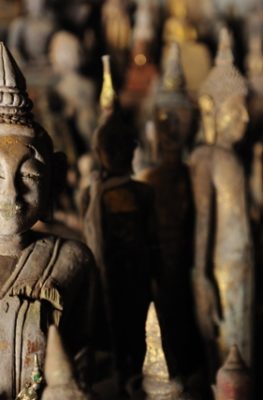Published on August 26, 2013

Herbivorous mammals don’t hurt anyone or anything. They are not predators. Yet due to host of reasons, primarily loss of habitat, there are lots of endangered herbivorous mammal species all over the world. Unfortunately, Southeast Asia is no exception. If you are a traveller who enjoys nature and wildlife, make it a point to visit ASEAN’s national parks where endangered species still survive in the wild. Tourism income provides an economic reason to add to the environmental, scientific, and moral reasons for the preservation of biodiversity. Here are nine remarkable vegetarians worth visiting in Southeast Asia.
Asian Elephant (Elephas maximus)
With between 34,000 to 54,000 Asian elephants left in the wild, the Asian elephant’s future, while not assured, is relatively safe compared to the other four species in this selection. In Southeast Asia, these impressive beasts are found in Indonesia, Cambodia, Laos, Malaysia, Myanmar, Thailand, and Vietnam.
The Asian elephant’s body and ears are smaller than the African elephant’s and they have relatively flat foreheads and curved backs. Females weigh around 2,270 kg and males weigh over 5,000 kg. Only some males have tusks. Females never have them. Adult males live alone or sometimes in small groups and never have much contact with females unless for mating. Females produce single calves after an 18 to 22 month gestation period. Calves depend on their mothers for about three to four years.
Asian elephants eat mostly plants and grass, twigs, bark, and leaves. But they eat a lot of vegetable matter; up to 150 kg of food a day. They spend up to 18 hours a day foraging for food. Because of the huge amount it consumes, the Asian elephant needs large forested areas and a permanent water supply for its habitat. Thus deforestation is the main threat to its survival.
Babirusa (Babyrousa babyrussa)
Not strictly vegetarian, the babirusa is found on Sulawesi, Indonesia and surrounding islands. They are omnivores, feeding mostly on fruit, leaves, and grasses, but will supplement their diet with fungi, nuts, insect larvae, small rodents and birds, and carrion.
The babirusa closely resembles a pig but scientists believe it may actually be related to the hippopotamus. It is also called the pig-deer because of its antler-like hooked upper and lower tusks, which are overgrown canine teeth. The upper tusks of males erupt through the top of the snout and curve back toward the eyes, giving them a very odd and threatening appearance. Babirusas are brown to gray in color and their skin is hairless. Their legs are long and thin. Adults reach over a metre in length and weigh up to 100 kg, and males are larger than females.
Babirusas can be found in the underbrush of tropical forests and canebrakes near the shores of rivers and lakes. Little is known about their behavior since they are secretive and shy. During the day, they may wallow in mud which helps rid them of insects and parasites. They prefer to graze at night and in small groups consisting of several females and their young. Males prefer to live on their own after they are mature enough to leave the group. When ready to mate they put their tusks to work fighting with other males. Females give birth to one to two young after a gestation period of 150 to 157 days.
Babirusas are endangered due to excessive hunting for their meat, and habitat loss due to agricultural development. Although it is legally protected, some hunting still occurs and farmers consider them a nuisance. It is estimated that only 4,000 individuals remain.
Bornean Gibbon (Hylobates muelleri)
The overall colouration of the animal is greyish brown with a line of lighter fur around its face. The animal generally has a darker coloured cap on its head. The Bornean giboon is also classified as endangered in the IUCN Red List category. In Brunei the species is protected by the law. The Bornean gibbon is only found in Borneo and can be sighted in primary forests and mature secondary forests, where they can be easier sighted feasting on mature figs. This species faces intensive population decline due to habitat fragmentation, destruction of its preferred habitats and illegal pet trades.

Bornean Yellow Muntjac (Muntiacus atherodes)
The Bornean muntjac (pictured above) is generally brownish, with a paler underpart. It has black bushy tail and only male muntjac has a dichotomously branched antler.
The Bornean yellow muntjac is another Bornean endemic and is classified as least concern in the IUCN Red List category. This deer species is normally found in the lowland area, as opposed to its counterpart, the red muntjac that seems to prefer hilly habitats. The Bornean yellow muntjac can be found in pristine lowland forests and mature secondary forests, where the animal can be found foraging for grass, fruits and seeds. The species faces population declines in Borneo due to habitat destruction and overhunting for its meat.
Javan Rhinoceros (Rhinoceros sondaicus)
The most endangered species in this selection, the Javan rhinoceros is now only found in Ujung Kulon National Park in Java, Indonesia. It is a prehistoric looking animal and one of the rarest large mammals in the world. Adults are gray in colour and have an armour-plated appearance, which is a result of large, loose folds of skin. Except for its ears and the tip of its tail, the Javan rhinoceros is completely hairless.
Javan rhinos prefer lowland rain forest with tall grass and reed beds where there is a good supply of water and plenty of mud to wallow in. Their diet consists of leaves, twigs fruits, and shoots. Since the Javan rhinoceros is the least studied of all rhinoceroses, very little is known about its behaviour. Both males and females are solitary, except when ready to mate or when the female cares for her young. Females give birth to one calf only once every one to three years. It is believed that the gestation period is 15 to 16 months.
The average weight of an adult is between 1,450 and 2,000 kg, and its body can be up to 3.5 meters in length and 1.7 meters at the shoulder. Like all rhinoceroses, it has a single horn that can reach up to 25 cm long on males. Female horns are smaller and some females are completely hornless.
Javan rhinos are endangered due to loss of habitat and hunting for their horns and other body parts used in Chinese medicine. In some areas one kilogram of rhino horn sells for approximately US$60,000. They are also hunted for meat. Less than 100 Javan rhinoceroses remain in the wild today in Indonesia.

A large monkey with reddish brown fur on the back, and paler underparts. Tail and rump of the animal are whitish, and adult male has the characteristic pendulum nose that normally hangs lower than the month.
Proboscis monkey (picctured right) is classified as endangered in the IUCN Red List category. In Brunei the animal is in the total protected list. Proboscis monkey is only found in Borneo, where it is normally foraged along mangrove and peat swamp forests. Proboscis monkey depends greatly for these habitats for its source of food, and leaves of young mangrove shoots contribute nearly half of the diet requirement. The major threat faced by this species is destruction of its habitat as wetland areas are normally thought to be wasteland or land that can be reclaimed for human settlement.
Seladang (Bos gaurus)
The seladang (also called the gaur or Indian bison) is found in tropical savannah woodlands, tropical monsoon and dry forests, and lowland tropical rainforests in India, Indochina, and the Malay Peninsula. They are said to be the largest of all wild cattle (even bigger than the Asian wild buffalo and the American Bison). They prefer relatively undisturbed forest tracts, hilly terrain below 1,850 metres, and an abundance of water, coarse grasses, bamboo, trees, and shrubs.
Seladangs prefer to be active in the morning and later afternoon and rest during the hottest time of the day. Males are solitary until the dry and mating seasons. During the dry season, they gather into herds led by one single adult male and remain in small areas. During the monsoon they travel to the hills. Females give birth to one or two calves after a gestation period of 275 days.
Adults grow to be very massive and muscular, reaching a shoulder height of about 1.8 metres. Males can weigh more than 950 kg and reach 3.4 metres in body length. Seladangs have a large hump at the shoulders, sturdy legs and a narrow dewlap (flap of skin) under the chin and between the front legs. Their heads are huge with a bulging forehead ridge between the horns. Both males and female have horns that grow up to 81 cm long and curve upwards. The coat of the seladang is short and dense, and its lower legs are lighter in colour.
Threats to the species include hunting (mainly for their horns), loss of habitat, and diseases that are transmitted by domestic cattle, such as rinderpest and foot-and-mouth. The seladang is legally protected throughout its entire range.

Tufted Ground Squirrel (Rheithrosciurus macrotis)
This large ground squirrel has dark brown upperpart and pale grey strip on the side and grey underpart. The tip of the ear has distinctive tufts of hair. The animal has large bushy tail, and is held high when the animal is actively foraging for berries and seeds on the forest floor.
The tufted ground squirrel is a Bornean endemic and is classified as vulnerable in the IUCN Red List category. This species is only found in pristine forests and is considered to be quite rare, often seem singly foraging on the forest floor. The population density of the squirrel faces decline due to habitat destruction and illegal hunting of the species for pet trades.
Visayan Deer (Cervus alfredi)
The Visayan deer is only found on the islands of Panay and Negros in the Philippines; in forests where natural disturbances such as fires or landslides occur. Fires and landslides allow for tender plants and young shoots of cogon grass to grow close to the ground. The deer also enjoy licking the ashes found on the forest floor after natural fires.
It is a small deer, growing less than 80 cm tall and weighing in at only 47 kg on average. Females are significantly smaller than males. The coat of the Visayan deer is dark-brown with spots on the back and flanks. The ears are short and only the males have antlers.
Visayan deer are social and prefer to feed at night. They are generally found in small groups of eight or less. Males fight and roar when they are ready to mate. Breeding may occur from November to December, and the female gives birth to one or two calves after a gestation period of 240 days.
The major threats to the survival of the Visayan deer include loss of habitat due to logging and agriculture, hybridization with a related species of deer (Cervus mariannus), and hunting. A captive breeding group was set up in the 1980s near Miagao in southern Panay, but the survival of this species is still uncertain.
Sources:
Pictures and Information about the Bornean gibbon, Bornean yellow muntjac, Proboscis monkey, and tufted ground squirrel courtesy of Dr. Ang Bee Biaw, Research Consultant, Brunei Heart of Borneo Centre, Ministry of Industry and Primary Resources, Brunei Darussalam.
For more information, pictures, and links about the Asian elephant, babirusa, Javan rhinoceros, seladang, Visayan deer, and many more, please visit Glenn, C. R. 2006. “Earth’s Endangered Creatures” (Online). Accessed 6/23/2013. Picture montage compiled from Wikipedia.






